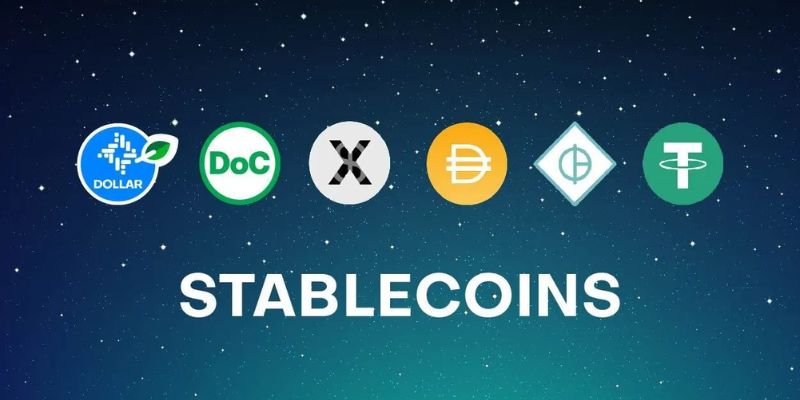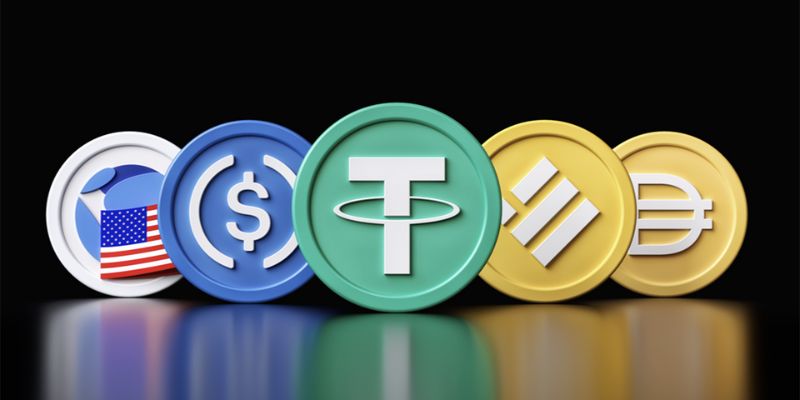Cryptos can be wild rides. Imagine one that holds its ground. That’s where the question, What is a stablecoin?, kicks in. These digital currencies cling to the promise of stability in the choppy seas of the crypto market. Think of them as your safe harbor, with a value that doesn’t swing with every market tweet. We’ll dive deep into how they work, why they’re gaining ground, and what this means for your wallet. Unpack the nuts and bolts of fiat-collateralized stablecoins, learn about the big players shaping the market, and wrap your head around the safety and legal talk. It’s time to get steady with your crypto knowledge—let’s start the journey.
Decoding Stablecoins: Defining Stability in Crypto
Types and Mechanisms of Stablecoins
Ever wonder why stablecoins have become a big deal? Let’s dig in. Stablecoins are a type of digital money. Their value doesn’t bounce around like other cryptos. That’s because they are “pegged” to something stable, like real dollars or gold.
There are a few types of stablecoins. The ones backed by cash or gold are called “fiat-collateralized stablecoins.” These are like having digital dollars in your pocket. Next, we have “crypto-collateralized stablecoins.” These are backed by other cryptos but take special steps to keep prices stable.
Then, you’ve got “non-collateralized stablecoins,” which are not backed by cash or crypto. They use algorithms to control their supply. If more people want them, the algorithm makes more. If not, it makes less.
Folks use stablecoins to make money or send cash fast without big fees. You can trade them on lots of sites. There are even places where you can lend your stablecoins and earn interest!
The Inner Workings of Fiat-Collateralized Stablecoins
Let’s zoom in on “fiat-collateralized stablecoins.” These are simple to get. A company holds a pile of real money in a bank. Then, they issue the same amount in digital coins. One real dollar equals one digital stablecoin, easy as pie.
When you want your real money back, you give them the stablecoin, they take it out of the game, and give you a real dollar. This keeps the stablecoin’s price from going up or down too much.
Tether USD is one famous example. But there’s more than just keeping a pile of cash. They need to make sure the money’s there, so everyone feels safe. That’s where “auditing stablecoins” comes in. Auditors come and check that the money matches the stablecoins out there.
Keeping these coins stable has its tricks, though. If people get worried and everyone wants their cash back at once, there could be trouble. That’s why the folks running it need to be smart about managing the money so they can keep their promise.
All this talk about stablecoins means lots of folks are trying them out. Every day, they’re getting more woven into how we handle money, shop, and invest. But like all money stuff, you’ve got to keep your wits about you. Not every stablecoin is built the same, and rules are still catching up.
So, next time you’re looking to step into the world of stablecoins, remember their secret sauce: staying stable in a world of ups and downs. It’s not magic, just smart finance mixed with tech savviness. And that, my friends, could be your ticket to a smoother ride in the sometimes rocky roads of crypto.
The Rise of Stablecoins in the Market
Examining Market Capitalization and Usage Trends
Stablecoins are climbing the ranks in the crypto world. This rise is thanks to their steady value. They hook right onto something stable, like a dollar, to keep their price from jumping all over the place. Let’s dig into why folks find stablecoins so handy.
First off, stablecoin market cap is growing fast. That’s the total value of all the stablecoins out there. More and more people use them every day for things like sending money and paying for stuff. It’s no wonder why—their stable value makes them a trusty choice in the wild sea of crypto that can go up and down a lot.
Spotlight on Prominent Stablecoins and Their Impact
Let’s shine a light on some well-known stablecoins. Tether USD is a major player. It’s tied to the value of a dollar. So, buying one is like getting a digital dollar. There are different types of stablecoins, like those backed by real money (fiat-collateralized) and those backed by other crypto (crypto-collateralized). Some even use math and algorithms (non-collateralized) to keep their value steady.
Think of stablecoins as the steady buddies in your crypto journey. They offer a calm ride. Are stablecoins safe, you ask? Well, they’re built to be stable. But, like any ride, there can be bumps. Always know what’s under the hood—like how stablecoins work and the rules that guide them.
Investing in them can be smart. But do your homework on things like stablecoin liquidity and fees. Also, see how easy it is to swap your stablecoins back into regular money (stablecoin redemption). These deets matter a lot.
Now, let’s chat about advantages of stablecoin, ok? You can trade them just like other crypto. But with less worry about wild swings in value. That’s a big plus if you ask me. And many even offer to pay interest when you lend them out. So cool!
Here’s some advice when thinking about stablecoin investments. Look at how they keep their peg, or tie, to what’s stable. This pegging trick is what makes them not bounce around in value. And always check if there are enough real bucks or other assets backing them up (auditing stablecoins).
When choosing, look at stablecoin comparison charts. They show you how each stacks up against others. Watch out for stablecoin risks too. Some might not be as stable as they say.
In a world that’s zooming towards digital money, stablecoins play a big role. They are the bridge between old-school money and new-fangled crypto. And with talk about countries making their own digital dollars (CBDC), things are getting even more exciting.
So, as we peek into the future, think of stablecoins as your trusty sidekick, keeping your crypto cash safe and steady. They might just be your best bet in a market that’s always on the move.
Navigating the Stablecoin Landscape: Safety, Investment, and Regulation
The Safety Debate: Are Stablecoins a Secure Option?
When it comes to stablecoins, safety is top of mind. Are stablecoins safe? Yes, they’re generally safe, but it varies. Now, let me tell you why. Stablecoins aim to be steady in the wildly swinging crypto world. They are like boats with anchors in the stormy sea of cryptocurrencies. These boats—stablecoins—are tied to stable things like dollars or gold. This helps keep their value from dancing around too much.
There are different types of stablecoins. Some, like Tether (USDT), connect their value to real dollars. They’re called fiat-collateralized stablecoins. Imagine you have $1, and you get 1 stablecoin for it. The company behind it keeps that $1 safe. They make sure your coin stays worth $1.
Then there are crypto-collateralized stablecoins. These ones use other cryptocurrencies to keep the boat steady. It’s like using a heavier boat to keep the smaller boat from moving too much. But those heavy boats can rock too. So, it gets tricky.
Non-collateralized stablecoins don’t use cash or other cryptos. They use smart contracts and rules to keep the value even. It’s like having a smart autopilot on the boat.
Stablecoin examples include USDT, USDC, and DAI. Each has its way to keep the value stable. And each has its safety measures. But storms happen. Markets can drop fast. When that happens, people rush to get their money back. This rush can test just how strong those anchors are.
Assessing Stablecoin Regulations and Their Implications for Investors
Stablecoins are new, and rules about them are still forming. Stablecoin regulations matter a lot. They can change how safe your investments are. Countries are now waking up to stablecoins. They’re trying to bring in laws to protect you and me. They want to make sure the companies behind stablecoins have enough dollars or gold to back up what they say. That way, if everyone rushes to get their money at once, the companies can handle it.
For investors, regulations can be a good thing. They offer more trust. With rules in place, we can feel better knowing that a dollar in a stablecoin is indeed a dollar. We can sleep easy. But, it can also mean more steps when you want to buy stablecoins or make trades with them.
So, here’s the deal. Stablecoins can be a safe harbor in the choppy crypto ocean. But, boats can sink, and storms can hit hard. We all need to wear life jackets, just in case. That means knowing how stablecoins work, keeping an eye on the market, and understanding the laws that protect our investments. It’s a wild ride, but with smart choices, we can enjoy the waves.
As we navigate the waters of stablecoins, we’re learning more each day. Steady as we go, we’re all part of this adventure, finding out just how mighty these crypto anchors can be.
The Future of Finance: Stablecoins, CBDCs, and Digital Economies
Exploring the Role of Central Bank Digital Currencies
Imagine your dollars going digital. That’s what central banks plan with their own digital money—CBDCs. Unlike the wild swings of Bitcoin, these digital dollars aim for rock-steady value. Think of them like a safe bridge between old-school cash and the fast pace of crypto.
CBDCs are central bank digital currency. They are like money in your bank but digital. You might hear folks say ‘digital dollar’ or similar names. It’s all about making the money we trust go modern. CBDCs could help us pay faster, save on fees, and much more!
Stablecoin Innovations and Their Potential Use Cases
Let’s chat about stablecoins. You might wonder, “How do stablecoins work?” Well, let’s break them down. Stablecoins keep their cool and stay close to a fixed value. There are many types of stablecoins out there.
One kind is the fiat-collateralized stablecoin. This type has real cash or assets backing it up, neatly tucked away. They offer a comfy feeling, knowing your digital coin is like real money in a safe.
Another kind, crypto-collateralized stablecoin, use other cryptocurrencies as backing. This sounds tricky, but it’s all about using a basket of crypto to keep things balanced. This way, if one crypto dances wildly, the others keep it in check.
Then, there’s the non-collateralized stablecoin. No real-world money or crypto backs these up. Instead, they use smart rules—algorithms—to keep their price stable. It’s like having a robot maintain the steady beat of the coin’s value dance.
What are the advantages of stablecoin? For starters, they can be snooze-fest stable. That’s great for everyday buys, sending money, or smart saving. They can be quicker and cheaper for global moves too. This is why stablecoin usage is on the rise.
Are stablecoins safe? They can be, but like all things money, there’s always a risk. Understanding how to buy stablecoins and what stablecoin risks exist is crucial. It’s like knowing both the sunny and rainy days when planning an outing.
The stablecoin market cap—that’s the total worth of all stablecoins—keeps growing. People and businesses see the value in a crypto that doesn’t swing like a playground swing. And with stablecoin trading, investors get a less bumpy ride.
But with all things finance, the rulebook matters. Stablecoin regulations help keep things fair and secure. We all want to play in a safe yard, right?
Now, stablecoin examples are everywhere, like tether USD. It’s good to compare them and see which fits your needs. With stablecoin peg mechanisms, each one will keep its value matched to something steady—like the dollar or even gold.
As for the cool new stuff, eyes on the stablecoin innovations. They might change how we do things—stablecoin lending, earning interest, even paying less for stuff. We’re talking about a financial makeover, friends!
There’s much to discover in the land of stablecoins and CBDCs. Together, they’re working on a digital money revolution. And that’s something to keep tabs on if you enjoy a mix of old, new, and steady in your wallet.
We’ve explored stablecoins, their types, and how they work, especially those backed by cash. We’ve seen their growth in the market, looking at famous ones and their effects. We’ve debated if they’re safe and peered into regulations. We even peeked at future money trends, like CBDCs and new uses for stablecoins.
Stablecoins show us where money is heading—digital and more stable than typical crypto. They’re a big deal in finance and will likely grow as we find more uses for them. So, money is evolving, and stablecoins are at the heart of this change. Keep your eyes open, and stay smart about where you put your cash. It’s a wild ride, but one that’s worth tracking!
Q&A :
What Exactly Is a Stablecoin?
A stablecoin is a type of cryptocurrency designed to offer more stability than traditional cryptocurrencies like Bitcoin or Ethereum. These coins are pegged to a stable asset, such as the US dollar or gold, with the intent to keep their value consistent and reduce volatility. This makes them a popular choice for investors who seek to avoid the sharp price fluctuations associated with other digital currencies.
How Do Stablecoins Maintain Their Stable Value?
Stablecoins maintain their value through various mechanisms depending on the type of stablecoin. Fiat-collateralized stablecoins hold reserves of a sovereign currency (like the USD) to back each coin in circulation. Crypto-collateralized stablecoins are backed by other cryptocurrencies but are over-collateralized to account for their volatility. Algorithmic stablecoins, on the other hand, use a programmable approach, automatically adjusting supply based on changes in demand to maintain a stable price.
Who Uses Stablecoins and Why Are They Useful?
Stablecoins are used by a wide array of individuals and organizations, including traders, investors, and businesses. Because of their stability, they are ideal for digital transactions, remittances, and as a safe haven during periods of high volatility in the crypto market. They also provide a bridge between the traditional financial system and the cryptocurrency space, enabling quicker and often less expensive transfers compared to conventional banking.
Are Stablecoins Regulated Like Other Forms of Currency?
The regulation of stablecoins varies by jurisdiction. While they are not regulated to the same extent as fiat currencies or traditional banking systems, regulatory bodies in various countries are working to establish frameworks to oversee stablecoin use, distribution, and integrity. This is an evolving area of financial law, and potential stablecoin adopters should keep informed of their local regulations.
What Are the Risks Associated With Investing in Stablecoins?
While stablecoins are designed to minimize volatility, they are not completely without risk. The risks can range from the collateral backing the stablecoin failing to cover its value, to regulatory changes impacting their legal status or use. Furthermore, technical issues on the blockchain platforms that host stablecoins could also affect their stability. Investors should always perform their due diligence before engaging with any cryptocurrency.





